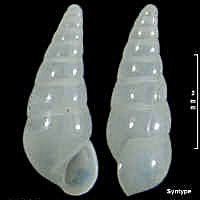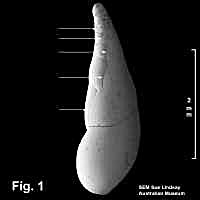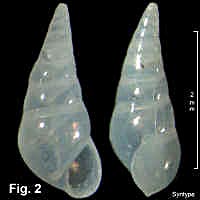|
< Previous family introduction |
|
|||||
 |
Family Eulimidae Eulimids
|
|||||
|
The Eulimidae is a family of molluscs that is parasitic on echinoderms - starfish, brittle stars, sea urchins, sand dollars, sea cucumbers and crinoids. The family is of worldwide distribution, occurring from the intertidal to the continental shelf, wherever their hosts occur. Some species are external parasites, more or less permanently attached to their host, and capable of detachment and reattachment. Other species are permanently attached or embedded in their host, or are completely internal parasites. The shell and anatomy of species is modified to some extent depending on their parasitic situation, even extending to complete shell loss in those species that are completely internal. Some species are restricted to a single host species, while others will parasitise closely related species. The eulimid - host relationship is, in general, not extensively documented. It is particularly poorly known for the NSW species, where many eulimids are known only from empty shells and their host is not known at all. In many eulimid species there are pronounced size difference between the sexes. Males are smaller, ranging from 10-70% of the size of the female. Other species are protandric hermaphrodites, changing sex, usually from male to female, on some environmental stimulus. In this situation, there may be a sudden change in shell morphology, such as is seen in Scalenostoma lodderae, where the male is a small, regularly conical shell, but after changing to female the shell rapidly and irregularly expands. Other eulimid species are simultaneous hermaphrodites, always found on the host as pairs. Shell form within the family is very variable; it ranges from long, slender forms as in Eulima, through wider forms such as Melanella, to globose shells as in Stilapex and Pelseneeria, and even to limpet-shaped shells of Thyca (none of these occur in NSW). The majority of shells are less than 10 mm in length, but a few reach up to 25 mm. Shell colour is often plain white, or colourless transparent in the minute species, but a few of the larger species are brown and patterned. A feature of the family is that the spire is often bent, which is a useful character for species identification. The family in NSW was revised by Charles Laseron in 1955; he created a number of new genera and described many new species. He was unable to assign species to pre-existing genera because of lack of literature and lack of access to type material, and some of his new genera have subsequently been found to be synonyms. Laseron worked entirely from empty shells, so did not have the advantage of animal anatomy to assist in classification. Later, Anders Warén revised the genera of the family in 1984. For some genera anatomical information had become available since the work of Laseron, but for others Warén had to continue with the existing placement based only on shell morphology. For example, the genus Melanella for which anatomical detail was available, Warén redefined the genus in anatomical terms, finding that shells of the included species encompassed a wide variety of shell morphology. There are about 35 species of the family recorded from NSW. A few of these are widespread Indo-West Pacific species, but most appear to be restricted to eastern and southern Australia. Only for a few species is there is enough material to confidently determine a range; for the remainder there is less than ten specimens available and for some only two or three, and the range is quite imprecise. Family Reference Laseron, C.F. 1955. Revision of the New South Wales eulimoid shells. Australian Zoologist 12(2): 83-107 Warén, A. 1984. A generic revision of the family Eulimidae (Gastropoda, Prosobranchia). The Journal of Mollusca Studies Supplement 13 1:96 Coverage All the species known to occur in NSW are detailed here. Identification Notes
|

